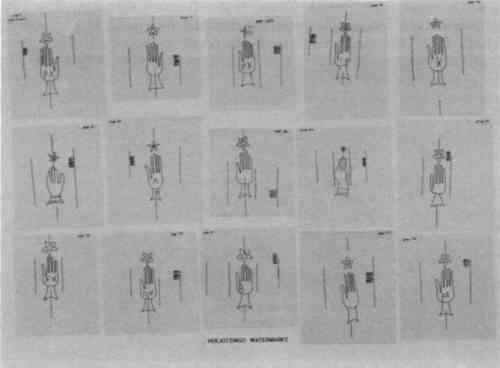THE EXAMINATION AND CONSERVATION TREATMENT OF THE LIBRARY OF CONGRESS HARKNESS 1531 HUEJOTZINGO CODEXSYLVIA RODGERS ALBRO, & THOMAS C. ALBRO
3 MANUSCRIPT TEXTVARIOUS ANTIQUE laid papers make up the text. They were identified as linen fiber by polarized light microscopy. A technical study of the paper revealed 16 different watermarks (fig. 10), all of the same “hand” or “gauntlet” design as that used in the 16th-century Italian papermaking industry in Genoa (Briquet 1955), a documented source for papers used by the Spanish in early Mexican colonial manuscripts (Mena 1926; Briquet 1955). Most of the conjugate leaves have deckled edges on four sides, indicating that they are whole, uncut sheets. They measure 31.8 � 43.6 cm, which corresponds exactly to the size described as re�ute (small) by a 14th-century papermaker's stone from Bologna, which exhibits incised sheet sizes (fig. 11).5 By the 16th century, the Italian papermaking industry was well organized, which explains why many of the papers used by the Spanish courts were from Italy and not Spain. A study of related Cort�s family papers in the
The text contains various dark brown inks written in at least 10 different calligraphies, as arguments on both sides of the case were presented and recorded by different hands. Based on records documenting ink used in the period, as well as the appearance and acidity of the manuscript ink, it is most probable that the ink contains iron (de Pas and Flieder 1976). The condition of the individual sheets was dependent upon the character and quantity of ink present. In one section of the manuscript (leaves 20–34), the ink was exceedingly acidic and had created many holes in the paper. These leaves could not be turned without losing fragments. The writing showed such extensive strike-through to the opposite side of the page that legibility was impaired. The most severe areas of damage had been mended with pressure-sensitive tape before 1942,7 and the adhesive subsequently had penetrated the paper, causing embrittlement and severe discoloration. The writing was completely illegible in these areas. Other sections of the manuscript exhibited similar ink damage but to a lesser degree. Discoloration was slight on leaves with little or no ink, and these pages were still quite flexible. The bottom edge of the manuscript was water damaged, blurring the writing in these areas. The paper color in general is an even, creamy white, and the surface pH measured from 5.6 to 6.0.8 Despite the tight sewing, exposure to handling, and acidic inks, the manuscript paper had withstood these damages and survived 500 years of natural aging because of its fine quality. The moderate climate of Mexico City, where the manuscript resided until 1929, also contributed to its survival. |

